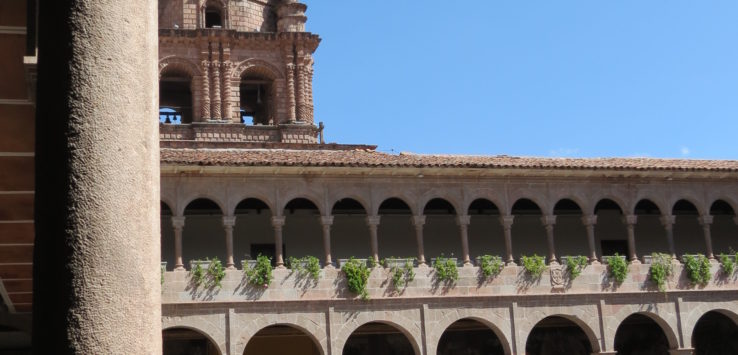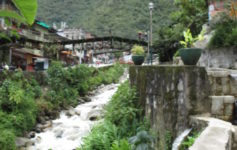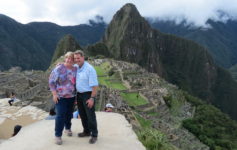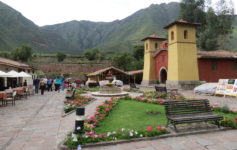Today we needed to wake up earlier to eat breakfast and meet our tour guide at 8:30 am for a walking and bus tour of Cusco this morning. Breakfast was good this morning. The buffet had pancakes (super small with jam), mini quiches, eggs, and various breads.
Santo Domingo Convent
At 8:30 am we meet our tour guide in the hotel lobby to visit several sites. We left the hotel at 8:35 am and walked about 5 blocks to our first stop, Santo Domingo Convent. Before entering the convent, our tour guide pointed out the original Inca wall construction. This construction showed that the outer part of the wall is built going inward. This is built to protect the walls from earth movement. The tour guide spent a great deal of time explaining the construction of the walls. I was able to find some very useful information regarding the Inca wall construction that I found interesting and confirms his decision with us. “Water engineer Ken Wright estimates that 60 percent of the Inca construction effort was underground. The Inca built their cities with locally available materials, usually including limestone or granite. To cut these hard rocks
the Inca used stone, bronze or copper tools, usually splitting the stones along the natural fracture lines. Without the wheel the stones were rolled up wood beams on earth ramps. Extraordinary manpower would have been necessary. Hyslop comments that the “ ‘secret’ to the production of fine Inca masonry…was the social organization necessary to maintain the great numbers of people creating such energy-consuming monuments.” Usually the walls of Incan buildings were slightly inclined inside and the corners were rounded. This, in combination with masonry thoroughness, led Incan buildings to have a peerless seismic resistance thanks to high static and dynamic steadiness, absence of resonant frequencies and stress concentration points. During an earthquake with a small or moderate magnitude, masonry was stable, and during a strong earthquake stone blocks were “dancing” near their normal positions and lay down exactly in right order after an earthquake.” Great description.
We arrived at the Santo Domingo Convent. This complex quite a history. The original building was an Inca temple, however sometime in the past history the Spaniards ended up building the convent on top of the template. However following a major earthquake in 1986, some of the original temple appeared. We
were able to some of the temple. Following our visit, I was able to collect the following information regarding this convent and temple. “ Qurikancha (Quechua quri gold, kancha enclosure, enclosed place, yard, a frame, or wall that encloses, hispanicized spelling Coricancha), originally named Inti Kancha (Quechua inti sun) or Inti Wasi (Quechua for “sun house”), was the most important temple in the Inca Empire, dedicated primarily to Inti, the Sun God. It was one of the most revered temples of the capital city of Cusco. Ci Inca Yupanqui rebuilt Cuzo and the House of the Sun, enriching it with more oracles and edifices, and adding plates of fine gold. He provided vases of gold and silver for the Mama-cunas, nuns, to use in the veneration services. Finally, he took the bodies of the seven deceased Incas, and enriched them with masks, head-dresses, medals, bracelets, sceptres of gold, placing them on a golden bench. The walls were once covered in sheets of solid gold, and its adjacent courtyard was filled with golden statues. Spanish reports tell of its opulence that was “fabulous beyond belief”. When the Spanish required the Inca to raise a ransom in gold for the life of
the leader Atahualpa, most of the gold was collected from Qurikancha.
Church of Santa Domingo
The Spanish colonists built the Church of Santo Domingo on the site, demolishing the temple and using its foundations for the cathedral. Construction took most of a century. This is one of numerous sites where the Spanish incorporated Inca stonework into the structure of a colonial building. Major earthquakes severely damaged the church, but the Inca stone walls, built out of huge, tightly-interlocking blocks of stone, still stand due to their sophisticated stone masonry. Nearby is an underground archaeological museum, which contains numerous interesting pieces, including mummies, textiles, and sacred idols from the site. The site now also includes the Church and Convent of Santo Domingo.” I have included several photos from this beautiful convent. I also included photos of the gardens that are next to the convent.
Main square in Cuzco
Following our visit at Santo Domingo, we walked several blocks to the main square in Cuzco. Cindy and I walked here last evening to shop, however it is daylight now. I have to admit I like the square better at night. I posted a few photos in the blog. We really spent no time in the square,
we rather headed directly to the Basilica Cathedral.
Cusco Cathedral
This is the only church in town that is part of the arch diocese of Peru. We were not able to take interior photos, however I was able to take a few off a site. They are included in the blog post along with exterior photos we took. This church was absolutely beautiful and had a lot of Spanish influence. Our tour guide gave an awesome tour of the Basilica, however I was able to document some research on the actual building. “The Cathedral Basilica of the Assumption of the Virgin, also known as Cusco Cathedral, is the mother church of the Roman Catholic Archdiocese of Cusco. The cathedral is located on the Plaza de Armas. Building was completed in 1654; almost a hundred years after construction began. Adjacent and joined to the cathedral is the smaller Iglesia del Triunfo, the first Christian church to be built in Cusco. The Iglesia de la Compania de Jesus, also on the Plaza de Armas, was built at a similar time as the cathedral. The Cathedral, in addition to its official status as a place of worship, has become a major repository of Cusco’s colonial
art. It also holds many archeological artifacts and relics. The cathedral was designated a UNESCO World Heritage Site under the City of Cuzco listing in 1983.”
Saqsaywaman
Following our tour of the Basilica Cathedral, we boarded a bus and went to an archeological site called Saqsaywaman. This archeological site was quite interesting. The Spaniards original thought this was a fortress; however it is a storage area for the Inca’s. The remaining standing wall is shaped like a lightning bolt. Here is a little additional research on this sites states the following. “Because of its location high above Cusco and its immense terrace walls, this area of Saksaywaman is frequently referred to as a fortress. The importance of its military functions was highlighted in 1536 when Manco Inca lay siege to Cusco. Much of the fighting occurred in and around Saksaywaman as it was critical for maintaining control over the city. It is clear from descriptions of the siege, as well as from excavations at the site, that there were towers on its summit as well as a series of other buildings. For example Pedro Sancho, who visited the complex before the siege, mentions the labyrinth-like quality of the
complex and the fact that it held a great number of storage rooms filled with a wide variety of items. He also notes that there were buildings with large windows that looked over the city. These structures, like so much of the site, have long since been destroyed. The large plaza area, capable of holding thousands of people, is well designed for ceremonial activities and several of the large structures at the site may also have been used during rituals. A similar relationship to that between Cuzco and Saksaywaman was replicated by the Incas in their distant colony of where Santiago, Chile now lies, with an Inca settlement that predated the city and the ritual site of Huaca de Chena. It is also clear from early accounts that the complex held a great number of storage rooms. Pedro Pizarro described storage rooms that were within the complex and which were filled with military equipment. The best-known zone of Saksaywaman includes its great plaza and its adjacent three massive terrace walls. The stones used in the construction of these terraces are among the largest used in any building in prehispanic America and display a precision of fitting that is unmatched in
the Americas. The stones are so closely spaced that a single piece of paper will not fit between many of the stones. This precision, combined with the rounded corners of the blocks, the variety of their interlocking shapes, and the way the walls lean inward, is thought to have helped the ruins survive devastating earthquakes in Cuzco. The longest of three walls is about 400 meters. They are about 6 meters tall. The estimated volume of stone is over 6,000 cubic meters. Estimates for the weight of the largest Andesite block vary from 128 tons to almost 200 tons.” One interesting point, the Pope visited this site in 1988. Apparently he was having hip problems so then ended up building a road to the hill where he appeared. The Pope was able ride in the Pope mobile.
Cristo Blanco
We spent about 45 minutes walking this area. Todd hiked a slight incline to explore a different point of view. Once we were done with this site, we boarded the bus and took a 5 minute ride to a statute of Christ or called Cristo Blanco. This was absolutely stunning and white for sure. There are a few photos
of this in our blog.
We spent about 15 minutes here and then headed back to the hotel. Some of the tour went on a separate bus to a silver shop. Once we arrived back at the hotel, Cindy and I quickly ate lunch at the hotel because we booked an extra tour, outside of your tour. We split a sandwich to keep it simple.
Moray and Maras
At 1:50pm, we meet our tour to visit Moray and Maras. There were 7 of us from the tour to visit this location. We had about 1+ hour drive from the hotel. Before arriving at our first stop, we pulled over to take pictures of the beautiful Andes and some of the snowcapped glaciers. I enclosed a few photos. Stunning views. We also passed by a school in the countryside which was crowded with parents or adults dressed in the traditional Peruvian clothing. We tried to stop and take photos; however some lady came up the bus and said no photos. Darn it.
We arrived at Maras which is famous for its salt mines. We first took photos from above, however when got closer to the mines, we were able to take
close up photos. We were able to walk next to the salt pools. The tour guide told us to stick our finger in the water and then taste it. It tasted like a heavy dose of ocean water. It is absolutely incredible to that this salt mine has been producing since the Inca times. Here is some particular information regarding this salt mine “Since pre-Inca times, salt has been obtained in Maras by evaporating salty water from a local subterranean stream. The highly salty water emerges at a spring, a natural outlet of the underground stream. The flow is directed into an intricate system of tiny channels constructed so that the water runs gradually down onto the several hundred ancient terraced ponds. Almost all the ponds are less than four meters square in area, and none exceeds thirty centimeters in depth. All are necessarily shaped into polygons with the flow of water carefully controlled and monitored by the workers. The altitude of the ponds slowly decreases, so that the water may flow through the myriad branches of the water-supply channels and be introduced slowly through a notch in one sidewall of each pond. The proper maintenance of the adjacent feeder
channel, the side walls and the water-entry notch, the pond’s bottom surface, the quantity of water, and the removal of accumulated salt deposits requires close cooperation among the community of users. It is agreed among local residents and pond workers that the cooperative system was established during the time of the Incas, if not earlier. As water evaporates from the sun-warmed ponds, the water becomes supersaturated and salt precipitates as various size crystals onto the inner surfaces of a pond’s earthen walls and on the pond’s earthen floor. The pond’s keeper then closes the water-feeder notch and allows the pond to go dry. Within a few days the keeper carefully scrapes the dry salt from the sides and bottom, puts it into a suitable vessel, reopens the water-supply notch, and carries away the salt. Color of the salt varies from white to a light reddish or brownish tan, depending on the skill of an individual worker. Some salt is sold at a gift store nearby. The salt mines traditionally have been available to any person wishing to harvest salt. The owners of the salt ponds must be members of the community, and families that are new to the community wishing
to propitiate a salt pond get the one farthest from the community. The size of the salt pond assigned to a family depends on the family’s size. Usually there are many unused salt pools available to be farmed. Any prospective salt farmer needs only locate an empty currently unmaintained pond, consult with the local informal cooperative, learn how to keep a pond properly within the accepted communal system, and start working.” The best time of the year to the see the salt mines is in May.
We were able to spend about one hour here walking around and taking photos. On our walk from the parking lot to the salt mines and then back to the bus, we walked past several vendors, many of them selling salt products in different colors and types.
We left the Maras area and headed to Moray. Before arriving at the Moray area we drove through the Moray small town. Our small bus basically took up the entire street. Pretty funny. We arrived at our last stop on our afternoon tour. This stop was Moray. The significance of Moray is “Inca agricultural greenhouse or laboratory that consists of four platforms that seem to
disappear into a crater. It is 500 ft in depth, the overlapping concentric circular stone rings wide as they rise. It was an experimental location the Incas used to study the adaption of plants with agriculture.” This area is incredibly interesting and fascinating. It is so incredibly hard to image that people had the fore thought and the physical ability to build something like this. I enclosed a are few pictures.
We left Moray a little late so we will be late getting back to the hotel. Our drive back to the hotel was super-fast and very bumpy. The driver was passing other vehicles at dangerously close calls with other vehicles. No nappage on the way back. We arrive at the hotel by 6:30 pm. Our tour guide arranged for a dinner at a local restaurant to include entertainment. We needed to be in the lobby by 6:50pm. Cindy and I dropped off a few items and then headed back to the lobby.
We thought we were walking to the restaurant; however there was a bus at the hotel to take us over. The restaurant was located in the center square, close to the hotel.
This evening
we ate at the La Retama restaurant. We ate upstairs. Our dinner was buffet style. Before eating, we drank a Pisco sour, surprise, ha. This is the Peru drink. After a toast with the tour director, we slowly migrated to the buffet area. All the dishes were Peruvian and all super good. The highlight of the evening was the roasted Guinea Pig. The tour director said the other day that he would have the restaurant prepare the dish for this. Most of the tour did not try, however I tried it. It was awful tasting. When preparing and eating the guinea pig, the chef cooks the entire animal, seasoned of course. The dish is served whole and you consumer every part of the guinea pig, I mean everything. I attached a few photos of the event.
Following our guinea pig situation, there were local entertainers dancing and playing Peruvian instruments. Some of our tour groups were picked to participate in the activities. The entertainers did a fantastic job and made this evening very special.
Dinner and entertainment was done around 9:30 pm so we boarded the bus and heading back to the hotel. Lights out for
Cindy and I. We had a really busy day and even busier one tomorrow. This is our last evening in a hotel. Tomorrow we fly back to Lima and get a hotel room to store our luggage and cleanup for dinner and then our flights home.
Please follow us on Facebook & Twitter ! We encourage you to visit our sponsors (ads) on each page.



















